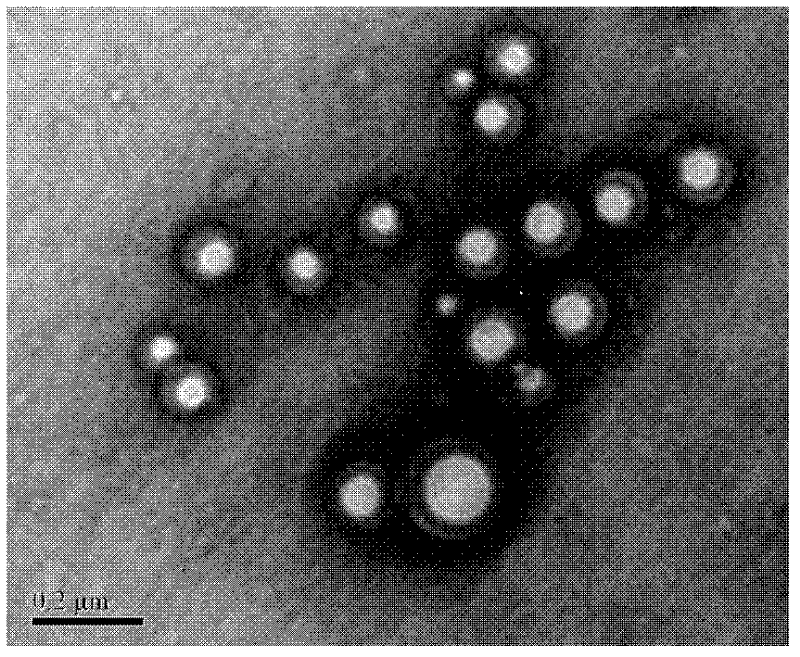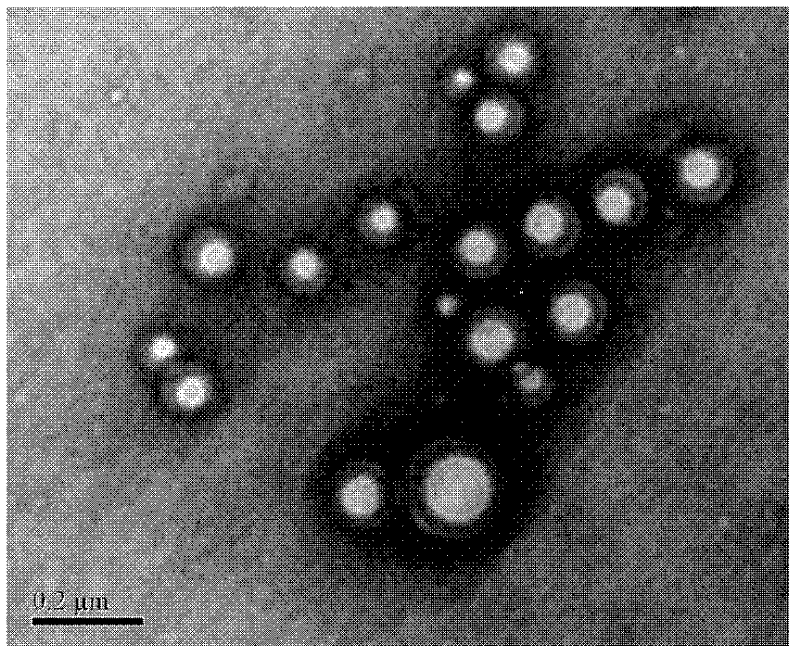Hyperbranched star polylactic acid-poly(2-methacryloyloxyethyl phosphorylcholine) block polymer nanoparticle prepared by volatilization method and method
A technology of methacryloyloxyethylphosphorylcholine and block polymer, which is applied in the preparation of hyperbranched star-shaped polylactic acid-poly 2-methacryloyloxyethylphosphorylcholine block by volatilization method Segment of polymer nanoparticles and fields, to achieve the effect of low critical micelle concentration and good dispersion
- Summary
- Abstract
- Description
- Claims
- Application Information
AI Technical Summary
Problems solved by technology
Method used
Image
Examples
Embodiment 1
[0015] 1. Take 0.01 mg of hyperbranched star-shaped SPLA-b-PMPC polymer in a small test tube, add 1 ml of acetone / water (1:0.1 by volume) mixed solvent into each test tube, shake gently to slowly disperse the polymer. Add 1ml of deionized water and a magnetic stirrer of appropriate size to a 25ml beaker, start stirring and adjust the speed, draw the acetone-water solution of SPLA-b-PMPC with a disposable syringe, inject it into the beaker at one time, and then evaporate the solvent at room temperature , get the product. attached figure 1 It is a transmission electron microscope picture of the obtained nanoparticles, and the particle diameter is about 50-80nm.
[0016] 2. Using the fluorescence spectrum of the pyrene probe to study CAC: measure the excitation spectrum of pyrene in different concentrations of hyperbranched star-shaped SPLA-b-PMPC polymer aqueous solution, it can be seen that the fluorescence intensity increases with the increase of the polymer concentration. W...
Embodiment 2
[0018] 1. Take 100 mg of hyperbranched star-shaped SPLA-b-PMPC polymer in a small test tube, add 10 ml of acetone / water (1:10 by volume) mixed solvent into each test tube, shake gently to slowly disperse the polymer. Add 100ml of deionized water and a magnetic stirrer of appropriate size to a 25ml beaker, start stirring and adjust the speed, draw the acetone-water solution of SPLA-b-PMPC with a disposable syringe, inject it into the beaker at one time, and then evaporate the solvent at room temperature , get the product. attached figure 1 It is a transmission electron microscope picture of the obtained nanoparticles, and the particle diameter is about 50-80nm.
[0019] 2. Study CAC with the fluorescence spectrum of the pyrene probe: measure the excitation spectrum of pyrene in different concentrations of hyperbranched star-shaped SPLA-b-PMPC polymer aqueous solution, it can be seen that the fluorescence intensity increases with the increase of the polymer concentration. When...
Embodiment 3
[0021] 1. Take 10 mg of hyperbranched star-shaped SPLA-b-PMPC polymer in a small test tube, add 2 ml of acetone / water (1:1 by volume) mixed solvent into each test tube, shake gently to slowly disperse the polymer. Add 9ml of deionized water and a magnetic stirrer of appropriate size to a 25ml beaker, start stirring and adjust the speed, draw the acetone-water solution of SPLA-b-PMPC with a disposable syringe, inject it into the beaker at one time, and then evaporate the solvent at room temperature , get the product. attached figure 1 It is a transmission electron microscope picture of the obtained nanoparticles, and the particle diameter is about 50-80nm.
[0022] 2. Using the fluorescence spectrum of the pyrene probe to study CAC: measure the excitation spectrum of pyrene in different concentrations of hyperbranched star-shaped SPLA-b-PMPC polymer aqueous solution, it can be seen that the fluorescence intensity increases with the increase of the polymer concentration. When ...
PUM
| Property | Measurement | Unit |
|---|---|---|
| Particle size | aaaaa | aaaaa |
Abstract
Description
Claims
Application Information
 Login to View More
Login to View More - R&D
- Intellectual Property
- Life Sciences
- Materials
- Tech Scout
- Unparalleled Data Quality
- Higher Quality Content
- 60% Fewer Hallucinations
Browse by: Latest US Patents, China's latest patents, Technical Efficacy Thesaurus, Application Domain, Technology Topic, Popular Technical Reports.
© 2025 PatSnap. All rights reserved.Legal|Privacy policy|Modern Slavery Act Transparency Statement|Sitemap|About US| Contact US: help@patsnap.com


